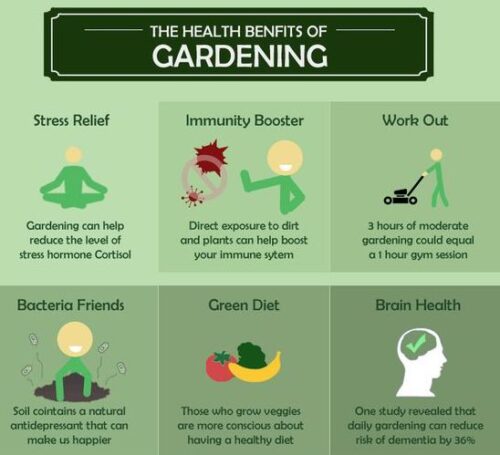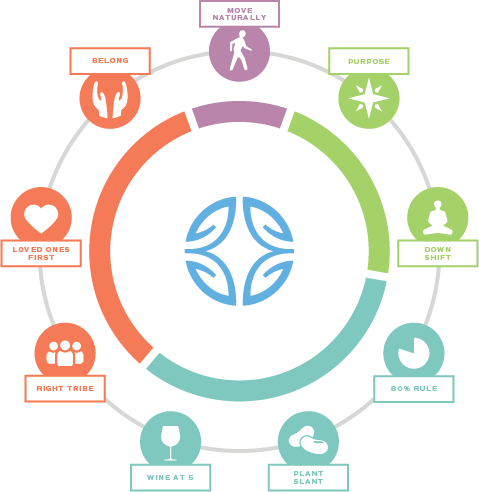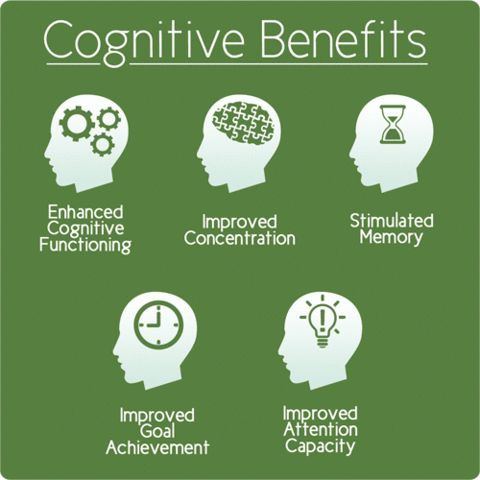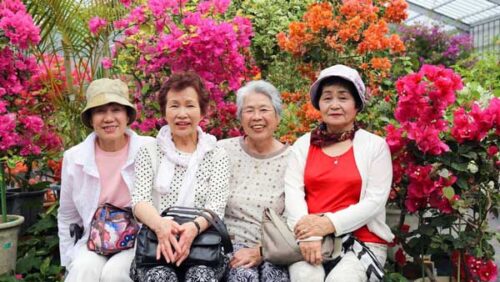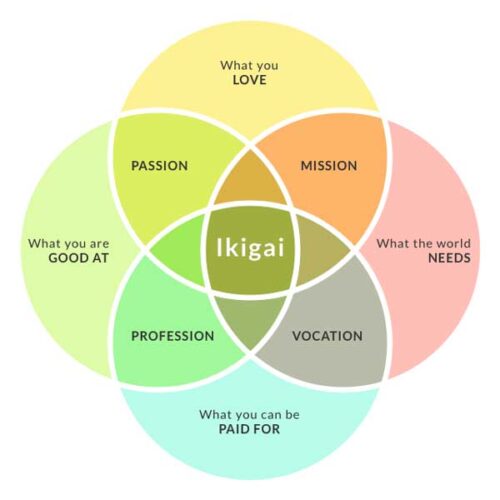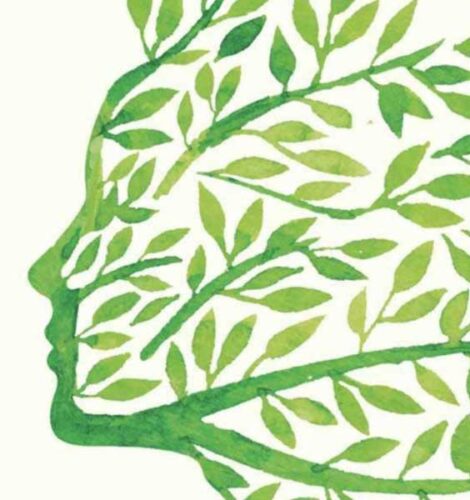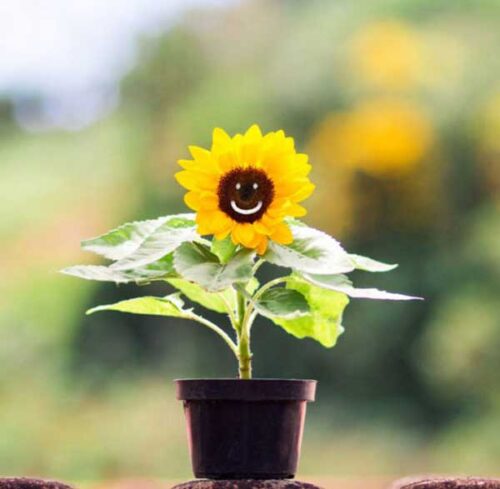Quality of Life
Here is a basic page layout with no sidebarThe link between green spaces and health has been shown time and time again, with increased access to and time spent in green spaces leading to improved mental and general perceived physical health. Green spaces can take many forms, with gardening being a unique subset that encapsulates the ideas of the Plant Eat Share (PES) movement. For this reason, gardening has the potential to extend your life and improve its quality through a variety of pathways, with benefits observed at all ages.
The medical benefits of being in natural spaces are so relevant that in some parts of the world, merely being outside in some form of nature can be officially used as a treatment for a variety of ailments. A program in Scotland created in 2018 permits doctors to give their patients “nature prescriptions” to help with certain issues, rather than resorting straight to or relying completely on pharmaceutical drugs. Doctors use these prescriptions with the goal of decreasing high blood pressure, anxiety, and increasing happiness for patients with diabetes, mental illnesses, chronic stress, and heart disease.
Why Gardening Specifically?
Why is gardening specifically so unique in the field of green spaces and health? Well, because gardening is able to combine a multitude of beneficial factors: physical activity, social interaction, exposure to both nature and sunlight, and access to healthy, fresh fruits and vegetables – a combination that leads to compounding beneficial effects on the body and the brain.
The Benefits of Gardening for the Elderly
The world’s oldest living people, so-called centenarians (over 100 years old), live in the world’s blue zones and have a select group of lifestyle factors in common (see the ‘Power 9’ lifestyle habits on your right) – they have strong social support networks, eat mainly fresh produce and raw foods, and in terms of hobbies, they garden well into their old age. In the context of aging, gardening helps to combat major complaints and issues in a few specific areas – both preventing and living with dementia, maintaining routine physical activity, and helping with poor mental health related to social isolation and a sense of lacking purpose.
Because of the abundant sensory stimulation and exposure to so much contextual information, gardening has been shown to decrease the risk of developing dementia altogether; in fact, an Australian study tracked and analyzed the relationship between lifestyle factors and dementia risk in men and women over the age of 60, and found that overall, daily gardening reduced the risk of developing dementia by 36% in comparison to non-gardeners.
These same factors have also been shown to be a successful technique to increase quality of life for elderly patients already afflicted with dementia. So-called ‘horticulture therapy’ for dementia patients is becoming an increasingly popular and effective treatment, using the senses to meet rehabilitation and therapeutic goals for each patient fully through the use of gardening – looking at, touching, tasting and smelling a variety of different plants.
Research has shown that horticulture therapy for dementia patients leads to benefits for mental health problems caused by their disease, as well as physical health issues related to aging in general. These benefits include a reduction in general pain, improvement in ability to pay attention, decreased feelings of stress and uneasiness, more control over feelings of agitation, lowering usage of ‘as-needed’ medications such as antipsychotics, and lastly, a decrease in fall risk; all of these factors combined lead to a longer and more enjoyable rest of their life.
An additional benefit that comes with gardening into old age is the physical activity aspect – simply put, gardening keeps the elderly moving and prevents the onset of immobility. The act of gardening itself tends to require more of a routine schedule than other options as plants need to be tended to on a regular basis, meaning that the gardener will be consistent in their physical activity. Regular gardening leads to increased muscle mass, aerobic endurance, flexibility, mobility and hand dexterity in seniors, promoting healthier aging.
Lastly, another impact that gardening in community contexts can provide is access to a social and supportive community, as seen with centenarians in Blue Zones. The elderly population is at high risk for degrading mental health, primarily due to social isolation and feeling as though they lack purpose. Gardening and sharing food are an effective way to help these issues – read more about how PES can help combat loneliness and build communities here.
Dr. Bradley Willcox from the University of Hawaii studies centenarians in one of the blue zones of the world – Okinawa, Japan. He talks about this issue, stating that “In Okinawa, they say that anybody who grows old healthfully needs an ‘ikigai,’ a reason for living. Gardening gives you something to get up for every day.” He also explains that Okinawans strongly value the notion of ‘yuimaru,’ social connectedness, which growing and sharing food provides.
The Benefits of Gardening for Everyone Else
While a majority of the benefits of gardening tend to revolve around mental health related problems, there are some benefits that arise from the pure physical activity that this hobby requires. Physical activity is an aspect of gardening that tends to show its benefits most significantly in old age, but it has also been shown to help improve symptoms of those with chronic health conditions – often linked to diet – such as high blood pressure, diabetes, obesity, and circulatory and heart diseases. Therefore for those younger than 65, there is potential for daily gardening to be used as a form of preventative medicine to avoid onset of these diet-related diseases, as well as a way to change lifestyle factors as both a treatment in itself and to reduce long-term reliance on pharmaceuticals, which can lead to harmful side effects on the body.
The most widely applicable benefit of gardening is improvement of mental health issues, whether chronic or acute. Given that 1 in 5 Americans will experience mental illness each year, whether that be anxiety, chronic stress, depression, etc., gardening has the potential to be very beneficial to a significant number of people. A variety of studies have shown the positive effects of gardening on mental health through reduction of symptoms especially from depression and anxiety, with a study even demonstrating that merely looking at a plant for 5 minutes led to significantly decreased systolic blood pressure, a physiological response that manifests as increased feelings of calmness and relaxation.
In a Dutch study, subjects that were given a stressful task and then gardened for 30 minutes upon completion had lower cortisol (stress) levels and better self-reported moods. These findings are significant because previous studies have shown the effects of gardening on mental health and more chronic general stress, but these results show for the first time that gardening leads to relief from acute stress – that is, stress caused by a particular situation.
And if mere environmental exposure does not convince you, let’s consider the connection between microbes in the soil and mental health. A diverse microbial community has been shown to have positive impacts on a variety of health issues, with the gut-brain connection being a newer and promising area of research. In relation to gardening, research has shown that a specific bacterium found in the soil, known as M. vaccae, actually mimics the effects of antidepressant medications in that exposure leads to serotonin production, an effect that can potentially be felt for up to three weeks. Gardeners easily inhale microbes within dust and have topical contact as well – even more of a reason to put your bare hands in the soil!
What You Can Do!
- Look for a community garden near you – most are open to the public, and many look for volunteers to help with daily gardening tasks; check the American Community Gardening Association’s Find-A-Garden feature or Dirt Doctor to find a garden near you
- Start your own garden – Real Homes has some good tips to get you started
- Embark on virtual visits to gardens across the UK for a quick mental health boost from the safety of your own home
- Read through this pamphlet given to patients along with their nature prescription in Scotland – it provides charming and eccentric suggestions for every month of the year and can be used as a source of inspiration to apply to wherever you live
Environmental urban planners and advocates are working to change the system from the top down, but there are many challenges – especially under the current administration – due to competing priorities, and funding and economic factors. Therefore, community gardens and the PES movement are a promising alternative route to cause tangible change in a shorter time frame and without the need to rely on elected officials. This bottom up approach means that neighborhoods and communities across the country can come together now to create green gardening areas in public and private spaces and take their health and livelihood back into their own hands – literally!
Lorem Ipsum Dolor
Nunc et vestibulum velit. Suspendisse euismod eros vel urna bibendum gravida. Phasellus et metus nec dui ornare molestie. In consequat urna sed tincidunt euismod. Praesent non pharetra arcu, at tincidunt sapien. Nullam lobortis ultricies bibendum. Duis elit leo, porta vel nisl in, ullamcorper scelerisque velit. Fusce volutpat purus dolor, vel pulvinar dui porttitor sed. Phasellus ac odio eu quam varius elementum sit amet euismod justo.
Lorem Ipsum Dolor
Nunc et vestibulum velit. Suspendisse euismod eros vel urna bibendum gravida. Phasellus et metus nec dui ornare molestie. In consequat urna sed tincidunt euismod. Praesent non pharetra arcu, at tincidunt sapien. Nullam lobortis ultricies bibendum. Duis elit leo, porta vel nisl in, ullamcorper scelerisque velit. Fusce volutpat purus dolor, vel pulvinar dui porttitor sed. Phasellus ac odio eu quam varius elementum sit amet euismod justo.
Lorem Ipsum Dolor
Nunc et vestibulum velit. Suspendisse euismod eros vel urna bibendum gravida. Phasellus et metus nec dui ornare molestie. In consequat urna sed tincidunt euismod. Praesent non pharetra arcu, at tincidunt sapien. Nullam lobortis ultricies bibendum. Duis elit leo, porta vel nisl in, ullamcorper scelerisque velit. Fusce volutpat purus dolor, vel pulvinar dui porttitor sed. Phasellus ac odio eu quam varius elementum sit amet euismod justo.
Lorem Ipsum Dolor
Nunc et vestibulum velit. Suspendisse euismod eros vel urna bibendum gravida. Phasellus et metus nec dui ornare molestie. In consequat urna sed tincidunt euismod. Praesent non pharetra arcu, at tincidunt sapien. Nullam lobortis ultricies bibendum. Duis elit leo, porta vel nisl in, ullamcorper scelerisque velit. Fusce volutpat purus dolor, vel pulvinar dui porttitor sed. Phasellus ac odio eu quam varius elementum sit amet euismod justo.
Lorem Ipsum Dolor
Nunc et vestibulum velit. Suspendisse euismod eros vel urna bibendum gravida. Phasellus et metus nec dui ornare molestie. In consequat urna sed tincidunt euismod. Praesent non pharetra arcu, at tincidunt sapien. Nullam lobortis ultricies bibendum. Duis elit leo, porta vel nisl in, ullamcorper scelerisque velit. Fusce volutpat purus dolor, vel pulvinar dui porttitor sed. Phasellus ac odio eu quam varius elementum sit amet euismod justo.


